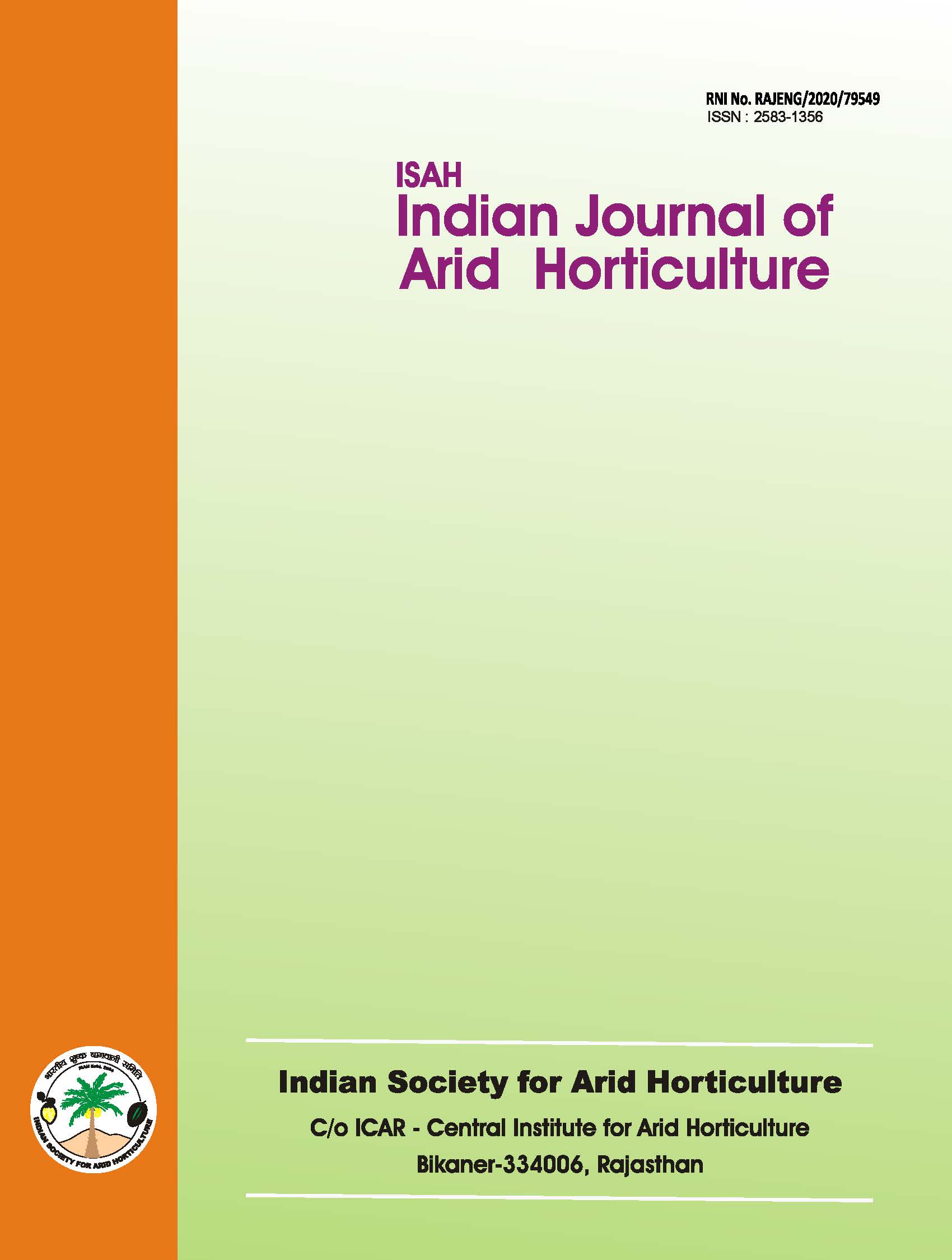Pollination and pollenization in fruit crops
Keywords:
Pollinalion, polfeni:,tllion,, pollenizers., pollinator effe,·tive pofli'1alion p,,riod.Abstract
Some fruit crops are monoecious in nature, while many others possess hermaphrodite flowers. On the contrary, certain fruit crops are dioecious. Various factors can affect effective pollination. Diploid plants produce abundant pollen; however, triploid plants fail to do so. Sometimes, flowers bloom earlier than the critical period of stigma receptivity, while in other cases, flowering may extend beyond the stigma’s receptive phase. Such variations disrupt the pollination process, making pollenization necessary.This article attempts to cover all such aspects of pollination and pollenization to enhance the understanding of these phenomena, ultimately improving fruit set.
Downloads
References
Akihama, T. and Omura, M. 1986. Preservation of fruit tree pollen. In: Bajaj, Y.P.S. (Ed.), Biotechnology in Agriculture and Forestry, Vol. I: Trees. Springer Verlag, Berlin, pp. 101-112.
Avila, R.S. Jr., and Freitas, L. 2011. Frequency of visits and efficiency of pollination by diurnal and nocturnal lepidopterans for the dioecious tree Randia ilatiaiae (Rubiaceae). Australian Journal of Botany, 59:176-184.
Bal, J.S. 2010. Fruit Growing. Kalyani Publishers, Ludhiana, pp. 250, 341.
Borrell, B.J. 2007. Scaling of nectar foraging in orchid bees. American Naturalist, 169:569-580.
Brain, P. and Landsberg, J.J. 1981. Pollination, initial fruit set, and fruit drop in apples: analysis using mathematical models. Journal of Horticultural Science, 56:41-54.
Brault, A. and de Oliveira, O. 1995. Seed number and an asymmetry index of ‘Mdotosh’ apples. HortScience, 30:44-46.
Chadda, K.L. and Pareck, O.P. 1993. Advances in horticulture. Vol. I: Fruit crops part I, pp. 464-479.
Chung-Kyoong Ho, Jun-Ji Hyal, and Kang Sangjo. 1998. Selection of suitable pollenizers for major Japanese plums. Journal of the Korean Society for Horticultural Science, 39(5): 560-563.
Orzet, L.R. 2002. Structure, function, and quality development in apples. Ph.D. Thesis, Massey University, New Zealand, pp. 160.
Fitzgerald, T. 2005. Pollination of fruit trees (C/05). Available at: https://spokane-county.wsu.edu.
Fishbein, M. and Venable, D.L. 1996. Diversity and temporal change in the effective pollinators of Asclepias tuberosa. Ecology, 77:1061-1073.
Garrau, M.P.D., Breese, T.D., Jenner, N., Polee, C., Biesmeijer, J.C., and Potts, S.G. 2014. Avoiding a bad apple: insect pollination enhances fruit quality and economic value. Agriculture, Ecosystem & Environment, 184:344-350.
Goodman, R. 1994. Honeybee pollination of fruit tree crops. Available at: http://agriculture.wa.gov.au.
Griggs, W.H. 1953. Pollination requirements of fruit and nuts. College of Agriculture, University of California, Berkeley, CA.
Guerra, M.E. 2011. Pollination and fruit set in Japanese plum. Ph.D. Thesis, Extremadura, Badajoz, Spain.
Hartmann, W. and Neumuller, M. 2009. Plum breeding. In: Priyadarshan, P.M., and Mohan Jain, S. (Eds.), Breeding Plantation Tree Crops: Temperate Species. Springer, New York, pp. 161-231.
Iqbal, M., Niamatullah, M., and Munir, M. 2012. Effect of various Dactylifera males as pollenizers on pomological traits and economic yield index of Phoenix dactylifera L. Journal of Animal and Plant Sciences, 22:376-383.
Kevan, P.G. and Baker, H.G. 1983. Insects as flower visitors and pollinators. Annual Review of Entomology, 28:407-453.
Michener, C.D. 2007. The Bees of the World, Second Edition. Johns Hopkins University Press, Baltimore, Maryland.
Muhtaseeb and Ghnairn. 2007. Effect of pollen source on productivity, maturity, and fruit quality of Hayyani date palm. Journal of Applied Horticulture, 9(2):170-172.
Nath, V., Kumar, O., and Pandey, V. 2008. Fruits for the Future, Vol. I: Well Versed Arid and Semi-Arid Fruits. S.S. Publishing House, Delhi, p. 149.
Overton, J., Winfree, R., and Tarrant, S. 2011. How many flowering plants are pollinated by animals? Oikos, 120:321-326.
Omura, M. and Akihama, T. 1980. Pollen preservation of fruit trees for gene banks in Japan. FAO/IBPCR Plant Genetic Resources Newsletter, 43:28-31.
Pathak, R.K. 2006. Loquat. In: Bose et al. (Eds.), Tropical Horticulture, Vol. I. Naya Prokash, Kolkata, pp. 386-389.
Partap, U. 2000a. Foraging behavior of Apis cerana on citrus (Citrus sinensis var. Red Junar) and its impact on fruit production. In: Asian Bees and Beekeeping: Progress of Research and Development, Proceedings of the Fourth AAA International Conference, 23-28 March 1998, Kathmandu. New Delhi: Oxford and IBH Publishing Co. Pvt. Ltd.
Partap, U. 2000b. Pollination of strawberry by the Asian hive bee Apis cerana F. In: Asian Bees and Beekeeping in Asia: Progress of Research and Development, Proceedings of the Fourth AAA International Conference, 23-28 March 1998, Kathmandu. New Delhi: Oxford and IBH Publishing Co. Pvt. Ltd.
Partap, U., Shukla, A.N., and Verma, L.R. 2000. Impact of Apis cerana pollination on fruit quality and yield in peach and plum in the Kathmandu Valley of Nepal. In: Matsubara, L.R., Verma, L.R., and Partap, U. (Eds.), The Asian Hive Bee, Apis cerana, as a Pollinator in Vegetable Seed Production, Kathmandu: ICIMOD.
Radha, T. and Mathew, L. 2007. Fig. In: Fruit Crops. NIPA, New Delhi, p. 319.
Ram, S. and Sirohi, S.C. 1994. Selection of pollinizer for mango cultivar Langra. Recent Horticulture, 1:14-17.
Randhawa, G.S. and Damodaran, V.K. 1961. Studies on floral biology and sex ratio in mango (Mangifera indica L.), III: Anthesis, dehiscence, receptivity of stigma, pollination, fruit set, and fruit development. Indian Journal of Horticulture, 18:51-64.
Salomon-Torres, R., Ortiz-Uribe, N., Villa-Angulo, R., Villa-Angulo, C., Norzagaray-Plasencia, S., and García-Verdugo, C.O. 2017. Effect of pollenizers on production and fruit characteristics of date palm (Phoenix dactylifera L.) cultivar Medjool in Mexico. Turkish Journal of Agriculture, 41:338-347.
Stanwood, P.C., Roos, E.E., and Towill, L.E. 1986. Cryopreservation of plant germplasm: A pilot research project. FAO/IBPCR Plant Genetic Resources Newsletter, 65:18-19.

